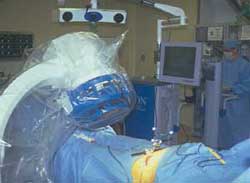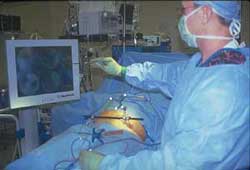More surgeons exploring the benefits of computer-assisted surgery
The use of CAOS in trauma, joint replacement and other procedures is greatest in Central Europe, less in North America.
A growing number of orthopaedic surgeons through-out the world are gaining hands-on experience with computer-assisted orthopaedic surgery tools in their clinic, although the costs of such equipment are still somewhat prohibitive.
The field of computer-assisted orthopaedic surgery (CAOS) tools and technologies is relatively young, but it is a field that is undergoing change very rapidly, said Rolf K. Miehlke, MD, PhD, treasurer and immediate past president of CAOS-International.
“Some of the most recent developments include the possibility to not only navigate cup orientation in the hip, but also to combine that with stem navigation,” said Miehlke, who is an assistant professor of orthopaedic surgery at St. Josef-Stift in Sendenhorst, Germany.
More orthopaedic surgeons are presenting details of their experience using CAOS tools in knee arthroplasty to perform proper ligament or soft tissue balancing.
“This is fairly new, and we have been using it [at St. Josef-Stift] for this purpose for 1½ years,” he said. “There were a number of articles addressing soft tissue balancing in total knee arthroplasty (TKA) at the CAOS-International meeting this year. This is, in fact, a major step forward because before this, we only navigated the resection planes on the distal femur and the tibial head. But that is only half of what we want to achieve. The other part, of course, is soft tissue treatment, and that is possible now [using CAOS].”
Another development in CAOS is high tibial osteotomy. “The results of doing high tibial osteotomy today are more reliable using navigation tools. This is an area where CAOS instruments really are making a difference,” he told Orthopaedics Today in a phone interview.
Results of navigated reconstruction of the anterior cruciate ligament have also been promising, he said.
Robotics in orthopaedic surgery
Just a few years ago, many orthopaedic surgeons and product developers were excited about the prospect of using robotic tools to perform joint implants and some trauma and spine surgeries on a routine basis. Some cardiologists use robots to perform heart surgeries.
|
COURTESY OF DAVID M. KAHLER |
While the use of robots has been well documented at several orthopaedic centers throughout the world, some surgeons remain reluctant to using one as part of their everyday armamentarium, according to Miehlke.
“In Germany, there was a lot of enthusiasm about robotics,” he said. He cited the influence of William L. Bargar, MD, of Sacramento, U.S.A., who was the first to use robotics in hip replacement surgery.
“He produced good results, but there are a number of shortcomings [with the technology],” he said. “One is that the robotics are still very bulky instruments, and both the Robodoc (Integrated Surgical Systems; Davis, U.S.A.) and the Caspar (orto Maquet GmbH; Rastatt, Germany) systems were derived [in part] from industrial robots. One shortcoming is the danger of impairing the soft tissues around the trochanteric region.”
Miehlke said that if you are able to prepare the bone down to a tenth of a millimeter precision-wise with a robotic burr, “that is excellent in terms of accuracy.” On the other hand, “The stem is then implanted manually, which isn’t really logical. This point wasn’t addressed much [in the early research], but it is one of the shortcomings,” he said.
“It only makes sense if you use the noncemented implantation technique [with robots]. Otherwise, you just don’t need to have such precision in the bony layer if you are using cement.”
Asia and Pacific Rim
Despite these challenges, many orthopaedists throughout Asia and the Pacific Rim are interested in exploring the potential of robotics and other CAOS tools, said Sung-Man Rowe, MD, PhD, president of the Korean Orthopaedic Association and a professor at Chonnam University Hospital in Gwangju, Korea.
|
“We have had much interest in robot-assisted arthroplasty because of its precision and accuracy. However, there have been some potential negative aspects of robotics in the orthopaedic field,” said Rowe, who discussed the topic of CAOS in Asia during the recent 3rd Annual Meeting of CAOS-International.
“The cost of the systems, the increased preparation and operating time, the added costs for imaging, accuracy and validation, and surgeons’ acceptance of robotics have been challenges. Among those, surgeons’ acceptance of robots and their high cost are the main obstacles in Asia.”
Because of these challenges, the use of many CAOS tools, especially robotics, is concentrated in just a few regions. Robots have been installed in only three of 47 Asian countries: Japan, Korea and India. According to Rowe, fewer than 15 orthopaedic surgeons in Asia mostly in Japan use robotics on a routine basis, while approximately 50 Asian orthopaedic surgeons use navigation routinely in their practice.
“Some Asian countries are still very cautious, like Japan, even though the tools are being used in some centers,” he said. “On the other hand, some Asian countries are very willing to use the tools, but the economic conditions there are not good enough [to support their use],” he told Orthopaedics Today in an e-mail response.
Preparing the next generation
Rowe added: “It is widely understood in Asian countries that computer- and robot-assisted surgery is one of the current hot topics in orthopaedic surgery, and we think it’s necessary to teach the residents and medical students how to use computers and robots for orthopaedic surgery. Therefore, all the national orthopaedic associations [in Asia] support the use of CAOS tools, although the systems are not perfect and [completely] satisfactory yet.
“My point of view on the future of CAOS is that its use will rapidly increase in the next five to 10 years [in Asia].”
|
|
Because robotics and navigation for total joint replacement have only been used routinely for the past two or three years in Asia, “installation of the tools themselves is the most exciting development taking place here right now,” he said. Specifically, the introduction of the pinless system in robotics and image-free navigation systems are also exciting advances, he said.
Miehlke agreed that surgeons and product developers are making great efforts toward improving navigation capabilities. Among the first CAOS navigation products offered internationally, he said, were the OrthoPilot by B. Braun/Aesculap, the VectorVision by BrainLab and the Navitrack by Centerpulse. Also in use in Europe and parts of Asia are systems by Praxim, Stryker Howmedica, Precision Instruments and Smith & Nephew, among others.
As in Asia, CAOS use in Europe is concentrated in certain regions, particularly in Central Europe. Perhaps nowhere is CAOS used more widely than in Germany, although many surgeons in France, Italy and the Netherlands have also used it, Miehlke said.
Still, product costs are prohibitive. “If a hospital administrator agrees to buy this system for the facility, it would cost about 120,000 euros. Unfortunately it is not covered by the insurance companies,” Miehlke said. “So, as a facility or orthopaedic department, you either offer it or you don’t, but the navigation systems have proven that they really contribute to more accuracy in aligning [implant] components properly. For that reason, I think it’s a good recommendation for a hospital to introduce such a system.
“I have no doubt whatsoever that navigation systems will make their way [to more clinics] in the future.”
Looking ahead
How CAOS technologies will be applied in more orthopaedic practices throughout North America in the near future remains to be seen, said David M. Kahler, MD, president of CAOS-International.
“Those of us who were interested in this field in the early years felt that orthopaedic trauma would probably have the most compelling applications for this new technology,” said Kahler, associate professor of orthopaedic surgery at the University of Virginia Health System in Charlottesville, U.S.A. “It seems clear that the implant companies are devoting most of their resources toward developing total joint applications.
“Nonetheless, image-guided sur-gery allows us to perform some pelvic trauma procedures with decreased invasiveness and more routine procedures such as intramedullary nailing with decreased radiation exposure. Despite the additional setup time required with CAOS, we have shown we can actually save operating room time during iliosacral screw insertion,” Kahler said in a fax response to Orthopaedics Today.
While fluoroscopic navigation has been commercially available for nearly four years in North America, “I am not sure why this technology has not yet been embraced by our traditionally techno-friendly specialty. I think that [U.S.] orthopaedic clinicians in general are still quite wary of CAOS applications. There remains a widespread perception that CAOS systems are complicated and costly, and that they add little value to the practice of a capable surgeon.”
Kahler said that the implant industry, especially in North America, is very competitive and will drive these systems to become less costly and easier to use in the near future.
“My gut feeling is that application-specific software, instruments and implants for CAOS will soon be readily available [here in the United States] and that most orthopaedic surgeons will be using them for some part of their surgical practice within the next decade. The advantages of this technology in terms of improved accuracy and decreased intraoperative radiation exposure are simply too great to ignore.”
Dr. Miehlke is a paid consultant for B. Braun/Aesculap.


 Rolf K. Miehlke reported that international
interest in navigation tools has soared.
Rolf K. Miehlke reported that international
interest in navigation tools has soared.